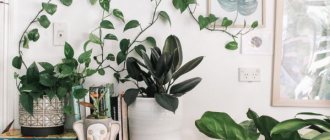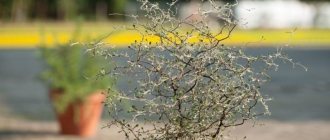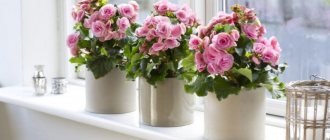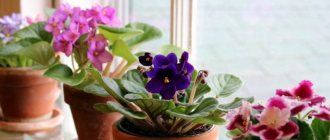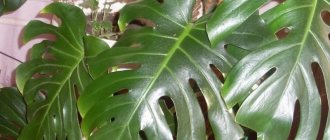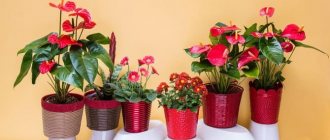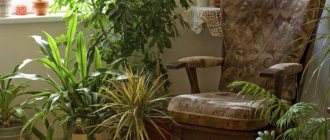Calamondin
A perennial tree of the oral family from East Asia, bred by crossing a kumquat with a mandarin orange. When grown at home, it reaches a height of 60-150 cm. The plant is distinguished by its juicy, dense greenery and bears fruit abundantly.
Calamondin does not tolerate direct sunlight and loves warmth. Feels best at a temperature of 18-20 ºC. In summer, the plant should be watered more abundantly than in winter.
Dracaena fragrant
A tall plant of the Asparagus family, native to Africa. In room conditions it can grow up to two meters. It has a woody trunk and long narrow leaves at the top of the crown and around the trunk.
Prefers moderate lighting at temperatures from 18 to 25 ºC, and is not afraid of shadows. Dracaena is unpretentious in care; it requires regular moderate watering without waterlogging the soil and loosening. Water for watering this plant should be settled.
We offer star ratings for large plants for the home and office.
Ficus , a symbol of family happiness and prosperity, has long been the favorite tree in our homes. In former times, a tub of large-leaved Rubber-bearing Ficus was one of the few living decorations. Other spectacular representatives of this very large genus have now become available. This is the Fig tree with large, almost round leaves, and the Ficus benjamina with many small leaves. The variety of sizes, shapes and colors of leaves gives scope for decorative solutions. Lush bushes up to the ceiling or elegant standard trees with several wicker trunks - the choice is huge.
Ficus is an ideal large tree for the home. It pleases with its rapid growth, bright green monochromatic or variegated foliage. It grows well in artificial light, which allows it to be placed away from windows.
The tree loves high air humidity. In winter, you can install a humidifier nearby. Since dust on the leaves makes it difficult to “breathe,” large leaf blades should be wiped and small ones should be sprayed. This procedure will refresh not only the plant, but also the air in the room.
There are many leaf care products that provide shine, repel dust, and act as foliar food.
A sudden change in temperature, draft or movement of the Ficus can cause it to shed its leaves. Don't be upset, it will come to life and turn green again.
IN THE PHOTO: Ficus rubber does not give up its high position in the popularity ranking
Dracaena is a very spectacular plant, often found in our homes. It adds a touch of exoticism to the interior. Textured patterned trunks are crowned with picturesque rosettes of narrow sword-shaped leaves, making the plant look like a palm tree.
Dracaena is very unpretentious. She loves good watering and regular feeding once a month. Periodically, the plant must be sprayed and the leaves wiped with a damp sponge. Maintaining high air humidity, especially in winter, is the key to success when keeping Dracaena in the house. Trimming the top will help regulate the height of the plant and will wake up dormant buds. Several rosettes will form from them, which will give the plant greater splendor. Dracaena with monochromatic leaves can be placed at some distance from the windows. Variegated species are more demanding on lighting. Several plants in one large pot will make an interesting composition.
IN THE PHOTO: Dracaena Sandera or indoor bamboo
Hamedorea is a beautiful, large, but slow-growing inhabitant of apartments and offices. The plant prefers diffused light and can grow up to the ceiling, creating picturesque thickets. Its sophisticated leaves on long petioles will unrecognizably transform any interior. Hamedorea is a real find for busy ladies who want to decorate their home or office. The plant is watered occasionally, the leaves are periodically sprayed and wiped. The preferred temperature is 16–18°C throughout the year. The plant responds well to fertilizing with mineral fertilizers.
IN THE PHOTO: Spectacular and bright leaves of Hamedorea will add color to a bright interior
Howea is the most unpretentious and spectacular palm tree, ideal for growing indoors. A fairly large plant will not create much trouble for the owner. She needs bright, diffused light and moderate watering. If you place the plant far from the window, then you should take care of organizing additional lighting with special lamps. The leaves need to be sprayed periodically.
The patterned trunk with marks from old cuttings and long pinnately dissected leaves give Khoveya a special decorative appearance. Plants are replanted only if absolutely necessary.
IN THE PHOTO: Howea is compact, but very decorative.
Washingtonia is also an eye-catching palm with fan-shaped, heavily dissected large leaves. A picturesque, powerful trunk with peculiar “scales” made from the remains of dry foliage, crowned with large leaves, reaching 1.5 m in diameter, on long petioles. Thanks to its impressive size - up to 3-5 m, the plant fits perfectly into the interior of fairly large rooms.
Washingtonia is easy to care for. In the summer, it is regularly watered and fed. Spraying the leaves will give excellent results and will maintain their rich color. The main danger in keeping the plant is excessive watering in combination with low temperatures in winter. You need to carefully monitor soil moisture. The plant also does not tolerate transplantation well. It is recommended to do it no more than once every few years.
IN THE PHOTO: Its impressive size and beautiful leaves will allow you to decorate large rooms.
Araucaria is sometimes called indoor spruce. They are really very similar. Bright green needles cover the branches of this plant. Some happy owners of a large Araucaria even dress it up for the New Year instead of a traditional Christmas tree. For all its external originality, it is easy to care for. Moderate watering, periodic fertilizing and spraying with soft water in hot weather will be the key to maintaining its decorative appearance.
The root system of the plant is compact and the need for replanting occurs very rarely. An important condition is to ensure a period of rest in winter. To prevent the plant from weakening, at this time it is kept in a cool room and watering is reduced. If the room temperature is too high and the air is very dry, the plant may begin to shed its lower branches prematurely.
IN THE PHOTO: Araucaria is an original alternative to the New Year's tree.
Nolina , Bocarnea or Elephant's Foot is an original representative of sultry and arid Mexico. It grows in hot deserts and can withstand high temperatures, drought, and direct sunlight. It also easily tolerates lack of lighting and excessive dry air in winter. It is still undeservedly rare in apartments. The plant's modest needs for watering and care, along with its high decorative value, will delight lovers of exotic flora. An interesting textured trunk, widened at the base, really resembles an elephant’s leg or a bottle. The plant stores moisture in it in case of drought. At the top, from many buds, long, hard, narrow leaves grow, forming a lush cap.
Bocarnea has a small root system. This allows even large plants to be kept in compact but wide pots. The tree grows slowly and feels great in the apartment.
IN THE PHOTO : The unusual, sculptural form of Bocarnea makes it a real decoration of the interior.
Hibiscus or Chinese rose attracts with its unpretentiousness, ease of care and high decorative value throughout the year. Hibiscus grows quite quickly, and the flowering tree becomes a real decoration of the house. The appearance of unusual colors and shapes of flowers makes it even more attractive.
Place the blooming giant near the windows. It does not need direct sunlight and can withstand lack of lighting perfectly. Although in the latter case the flowering will still be weaker. In order for the crown to develop evenly and buds to form on all branches, the flowerpot must be periodically turned 45° towards the light source.
You can curb the growth of Hibiscus, give it the desired shape and achieve greater crown density by formative pruning.
The plant is watered as the soil dries. Periodic feeding alternately with mineral and organic fertilizers will help increase the intensity of flowering.
IN THE PHOTO: Blooming Hibiscus - a piece of summer in your own apartment.
IN THE PHOTO: Hibiscus can be formed into a standard or a classic bush - it depends on your preferences! Don’t forget to prune every spring, not sparing weak shoots, and then all autumn and winter the “Chinese rose” will delight you with huge flowers.
Regardless of whether you are a lover of indoor plants or perceive them as spectacular design objects, indoor flora in the house should not be neglected. Even if you sometimes don’t have enough energy or time to care for it, you can always choose less demanding types.
Dieffenbachia
A popular houseplant of the araceae family, imported from South America, named after a botanist from Germany. Loves light and warmth, but needs protection from the scorching rays of the sun.
The plant has thick stems with large variegated leaves. If the stem is damaged, it releases poisonous juice that can cause a burn if it comes into contact with the mucous membranes of the eyes, nose or mouth. Caring for Dieffenbachia is not difficult; just water the plant generously and maintain the room temperature at least 18 ºC.
Anthurium
This flower is considered a kind of amulet that protects the house and its inhabitants from the effects of negative energy. The shortened stem, which can be aboveground or underground, is covered with green leaves reaching 15 cm in length and 7 cm in width. Flowers can be of a wide variety of colors - from white to burgundy. When caring for this indoor flower with large leaves, you must adhere to a number of rules:
- Protect it from drafts.
- The plant should be kept at a temperature not exceeding +20 °C.
- In winter it is necessary to remove it from heating devices.
- The plant should be placed on an eastern window with diffused but bright light.
- The flower needs regular watering.
- It is carried out after the top layer of soil has dried.
- This flower loves humidity, so it is advisable to spray it with water twice a day and ventilate the room well.
The anthurium inflorescence is a spadix that is surrounded by a dense, bright blanket of various colors - from white to dark purple. Two-colored varieties are also common, but the most popular are yellow, orange and red.
You may be interested in: Cyclamen diseases: names, descriptions and methods of treatment
Sansevieria
A perennial ornamental plant without stems, popularly called “mother-in-law’s tongue.” The genus belongs to the agave family and includes approximately 60 species. Under natural conditions, the succulent can be found in Indonesia, India and Africa.
It has strong, long leaves that have the ability to store water, so it can easily tolerate skipping watering. The plant loves warmth and does not need frequent watering or replanting. The optimal temperature for keeping it is not lower than 18 ºC.
Philodendron
A heat-loving tropical plant, evergreen, with thick stems and large fleshy leaves. Most common in the Pacific Islands, Australia and America.
Due to its large size, philodendron can only be grown in a spacious room, using support for better growth. The plant prefers high air humidity, is heat-loving, does not tolerate drafts and requires regular watering.
Indoor plants useful for an apartment
Are you choosing indoor flowers for the kitchen and want them to be useful for your home? Pay attention to peppermint. It can be grown not only outdoors, but also in pots
The plant stimulates appetite, improves digestion, and its leaves can be added to tea or various dishes.
An indoor violet (Saintpaulia) will help purify the air. It is unpretentious and blooms at any time of the year. White Saintpaulia, according to experts, can be placed in any room, and pink and red ones - in the kitchen. The plant does an excellent job of purifying the air and smoothing out temperature changes.
Scindapsus does not require special care and does an excellent job of purifying the air. A flowerpot occupied by a fast-growing vine will look great both on the wall and on a shelf in the kitchen.
Cactus is a protective plant. It should be grown on windowsills and is useful to have in work rooms. The thorny flower, when properly cared for, eliminates negative energy and absorbs positive cations that can cause headaches. Experts believe that cacti can be placed in any room except bedrooms, as they cool sexual fervor.
Cactus. Useful indoor plants: names, photos, properties.
If you are trying to understand which indoor plants are useful for the home, then know that they are the same as for the apartment. You can buy flowers at any time of the year. Before paying for a flower, carefully inspect its stem and leaves: they should not be rotten, stained, parasites or pests.
Calathea
An ornamental deciduous plant of the arrowroot family with large variegated leaves on long cuttings, distinguished by its grace. Calathea is quite capricious; it prefers a quiet place with moist air; low temperatures from 16 to 22ºC are suitable for it.
At higher indoor temperatures, it is recommended to periodically check the soil. Calathea should be fed with fertilizers from time to time, regularly sprayed and watered.
Houseplants that are good for human health
Some of the most useful indoor plants for an apartment, while purifying the air, improve health and help cope with certain diseases.
Healthy indoor plants are:
geranium, also known as pelargonium. Its aroma relieves nervous tension and reduces the manifestation of functional disorders of the nervous system, such as stress, neuroses, and insomnia. The leaves secrete geraniol, which has antibacterial and antiviral properties, thanks to which geranium kills viruses, streptococci and staphylococci. Pelargonium fights carbon monoxide, dampness and stagnant air. It can be kept both in the bedroom and in the kitchen;
Tree aloe, also known as agave, is considered by many to be the most useful indoor plants for the home. They contain substances that absorb fumes emitted by linoleum. Its presence in the room reduces the electrification of the air and has a positive effect on the human biofield. At night, the plant produces oxygen, so it should be placed in the bedroom.
Aloe. Useful indoor plants: names, photos, properties.
Aloe has antibacterial, choleretic, anti-inflammatory, and wound-healing properties. Its juice improves appetite, normalizes digestion, improves immunity and restores damaged tissue;
asparagus will become indispensable in the presence of chronic diseases. Its presence in the house helps to heal broken human bones, restore damaged skin and skin elasticity. The plant destroys many pathogenic bacteria, absorbs heavy metals contained in the air;
Asparagus. Useful indoor plants: names, photos, properties.
Rosemary officinalis is one of the most useful indoor plants for people suffering from bronchial asthma, chronic bronchitis, catarrh of the upper respiratory tract or emphysema. The phytoncides it secretes alleviate the general condition, helping in the fight against these diseases;
Rosemary. Useful indoor plants: names, photos, properties.
Kalanchoe is a useful indoor plant for humans with antibacterial properties. The flower helps strengthen the immune system and prevents the occurrence of colds.
Kalanchoe. Useful indoor plants: names, photos, properties.
Tradescantia
A climbing plant with creeping stems, reaching a considerable length and growing well in breadth thanks to regular pinching. The leaf plates are alternately located on the stem and can have a variety of shades and shapes.
A very sun-loving plant, it feels great at room temperature and does not tolerate frost. Requires moderate watering and periodic feeding in the summer.
Date palm
This tall plant has earned special affection from gardeners. And all thanks to the thick spreading crown, rapid growth and attractive appearance. In addition, the plant has an unpretentious nature, and, despite its exotic origin, it takes root well in apartment and office conditions. And with proper care, it reaches two meters in height in 5-7 years. And if desired, an exotic beauty can be grown from a seed.
Caring for a date palm is easy. Provide it with abundant watering from spring to autumn, and under no circumstances allow the soil to dry out. Otherwise, the leaves of the tree will droop and never return to their previous state. In winter, reduce moisture, as stagnant moisture will cause the roots to rot. At any time of the year, spray the leaves of the crop daily and periodically give the plant a warm shower. A resident of the tropics responds well to fertilizing and fertilizers. Apply them twice a month, and the palm tree will thank you with rapid growth and a lush, spreading crown.
Japanese fatsia
A large ornamental deciduous plant with medium-sized palmate leaves - up to 35 cm. It is a similar genus of the Araliaceae family. All parts of the flower contain poison, so it is not recommended to place it in a child's room.
For maintenance, it is necessary to provide good lighting, humidify the air, regularly water, spray and fertilize once a week.
Large indoor plants are used to decorate rooms for various purposes. In addition, they perform very important functions: they purify the air and help create a positive emotional background. Palm trees and ficus trees are distinguished by their originality and can decorate any room in the apartment.
Site Digest
Buying indoor plants: step-by-step instructions. — We buy indoor plants that will grow and delight us for many years. The site will tell you how to make the right choice!
Climbing indoor plants: everything you need to know about care - In this article we will talk about climbing indoor plants, their types and names, show photos and give some useful tips for care
Plants for interior decoration - What plants will decorate the interior and require a minimum of care? We have prepared some simple tips for choosing and placing indoor plants in the interior.
When and how to fertilize plants? Part 1 - When to feed plants, what feedings and at what time will bring the greatest benefit to indoor and garden plants.
How to repot indoor plants - repotting indoor plants. We'll tell you and show you how to do it correctly and usefully for our green friends!
